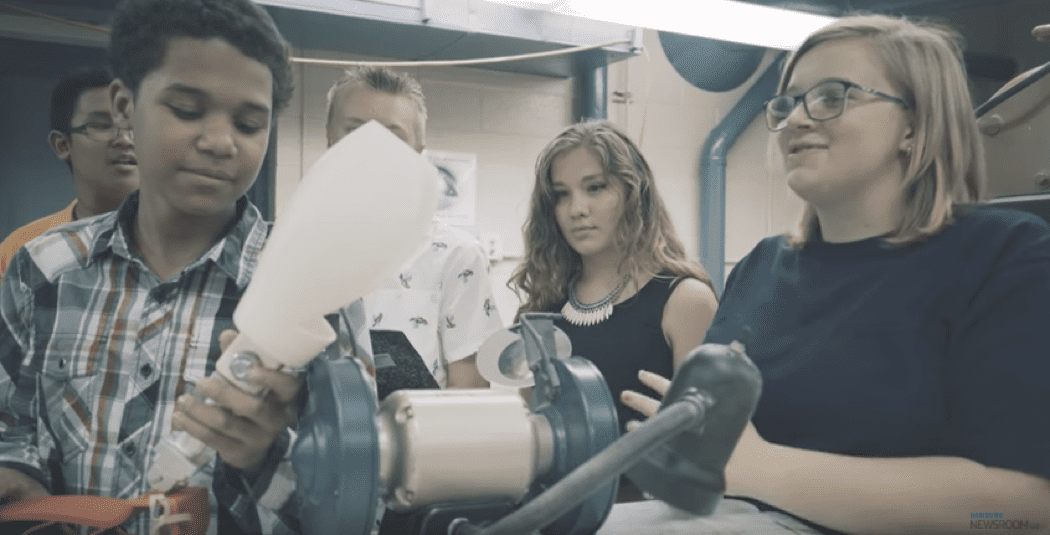Living near Buckley Air Force Base in Aurora, Colo., many students at Horizon Middle School know injured military members. When Kyle, a local Gulf War veteran who lost a leg, visited the class to talk about his experiences, something shifted in the students’ minds. Kyle was struggling to get a prosthetic leg that fit comfortably.
The eighth grade engineering class was determined to help.
“Because we are middle schoolers, people think we are young and that we are incapable of doing things. We thought, ‘Hey, let’s prove the world wrong,’” said Simon-Peter Frimpong, a student in the class.
In the fall of 2015, the Horizon Middle School students—40 in all, working in teams of five—began designing a perfect prosthetic leg for Kyle in what they hoped would be a winning entry in the Samsung Solve for Tomorrow contest.
The nationwide contest encourages students to use their skills in science, technology, engineering, art, and math (STEAM) to create change in their communities.
[embedyt] https://www.youtube.com/watch?v=yu-klpxzkgU[/embedyt]
The Horizon teams researched anatomy, designed different 3D prosthetic models on the computer using CAD software and critiqued each other’s approaches.
After creating more than 100 prototypes (working on patents along the way), they refined their idea and printed it. For their innovative prosthetic design, Horizon Middle School was named a national winner of the Samsung competition in 2016.
“They really took to it heart and worked hard. They knew they could make a difference,” said Horizon teacher Melinda Possehl.
As they dove into the design process, Possehl said the students didn’t realize they were getting lessons in physics and thermodynamics that would prepare them for high school. “We need to all get out of our box and realize these kids have amazing minds,” she said. “You just have to build that self-esteem in them.”
Frimpong, one of the lead students on the Horizon team, said he liked how the project was hands-on and practical. “The knowledge you learn from other classes can go into good use,” he said. “Actually, using it is more meaningful and you can understand it better.”
After the team became state finalists in the Samsung competition, the students began to take the work more seriously.
As they advanced through the phases, it was “all hands-on deck” to prepare for the finals, said Frimpong. Eventually, as a national winner of the Solve for Tomorrow contest, the Horizon students won the ultimate trip to Washington, D.C., for the White House Science Fair, where they presented their winning project to President Obama, who Frimpong said was “so tall,” as well as personable. Everyone they met in Washington was encouraging, said Frimpong, who returned to Colorado wanting to do more to help others in his community needing prostheses. He is now a sophomore in high school, involved in robotics design, and plans to pursue a STEM major in college.
The experience was transformational for the kids—some of whom weren’t strong students entering the class, but emerged as leaders by the end of the year, said Possehl.
“Their life path is different because of the confidence they gained,” she said.
Winning the competition at age 13 was a like dream, said Grayson Fast, another student on the Horizon team. “It was so surreal. No one thought we would reach that level. It was really empowering…to think that we could do something even more,” she said. Fast said presenting the project at a science fair in the Blue Room of the White House was both scary and exciting. She’ll always remember President Obama’s response: “He said he was really proud of us and that what we were doing was an accomplishment at our young age.”
Grayson, who is now a 10th grader, said the experience gave her confidence and a solid academic foundation. She plans to study biomedical engineering in college.
Possehl said that throughout the process, when the kids would question their abilities, she’d always reassure them. “I believe if you use your imagination, there is nothing that you cannot do,” said Possehl. “I know the world is going to be a safer place and a better place because of these students.”
Attention teachers: This year’s Samsung Solve for Tomorrow contest is up and running! It’s open to public school students in grades 6-12. Teacher applications are being accepted now through Nov. 9—check it out.



